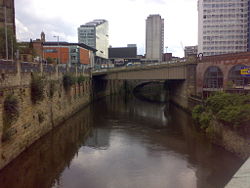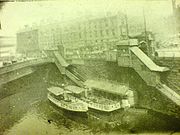
Manchester Cathedral Steps
Encyclopedia

River Irwell
The River Irwell is a long river which flows through the Irwell Valley in the counties of Lancashire and Greater Manchester in North West England. The river's source is at Irwell Springs on Deerplay Moor, approximately north of Bacup, in the parish of Cliviger, Lancashire...
in Manchester
Manchester
Manchester is a city and metropolitan borough in Greater Manchester, England. According to the Office for National Statistics, the 2010 mid-year population estimate for Manchester was 498,800. Manchester lies within one of the UK's largest metropolitan areas, the metropolitan county of Greater...
. They served as business premises, landing stages for Steam packet riverboats, and also as World War II
World War II
World War II, or the Second World War , was a global conflict lasting from 1939 to 1945, involving most of the world's nations—including all of the great powers—eventually forming two opposing military alliances: the Allies and the Axis...
air-raid shelters. They were accessed from wooden staircases which descended from Victoria Street.
Regular flooding of the river resulted in the closure of the steam-packet services in the early 20th century, and the arches were used for general storage. In World War II
World War II
World War II, or the Second World War , was a global conflict lasting from 1939 to 1945, involving most of the world's nations—including all of the great powers—eventually forming two opposing military alliances: the Allies and the Axis...
the arches were converted for use as air raid shelters. The arches are now bricked up and inaccessible; the staircases were removed in the latter part of the 20th century.
Background
In 1838 the city authorities completed construction of a new embankment along the River Irwell, to support a new road. The arches were built at the same time, and created new industrial space.In 1852 the life-boat Challenger was built and launched from the Arches.
In the Victorian era passenger trips along the river Irwell were very popular although it was becoming increasingly polluted. In 1860 the Irwell was described as "almost proverbial for the foulness of its waters; receiving the refuse of cotton factories, coal mines, print works, bleach works, dye works, chemical works, paper works, almost every kind of industry." The Rivers Pollution Prevention Act 1876 was designed to solve this problem, but it was largely ineffective. It did however lay the groundwork for the more draconian legislation which followed..
Packets

Manchester Ship Canal
The Manchester Ship Canal is a river navigation 36 miles long in the North West of England. Starting at the Mersey Estuary near Liverpool, it generally follows the original routes of the rivers Mersey and Irwell through the historic counties of Cheshire and Lancashire. Several sets of locks lift...
in 1894, in 1895 at least one landing stage was opened by the Manchester Ship Canal Company, who actively encouraged passenger traffic. The company purchased several steamers, two of which, the Shandon and the Eagle, are known to have used the landing stages. The boats could carry 900 and 1,100 passengers respectively. During the first half of 1897 more than 200,000 passengers were carried on trips around Manchester Docks, with holiday seasons the most popular periods. Competition for passengers was fierce, and there were at least two landing stages, operated by different companies. The ferries would occasionally carry musicians, for passenger entertainment.
The stages suffered problems with flooding of the Irwell, and do not appear to have remained in business for long; they were closed in 1906. In Underground Manchester; secrets of the city revealed, author Keith Warrender quotes from the recollections of a Manchester City News writer published in 1923 about the arches (he calls them "Victoria Arches"), sixty years previously;
He continues, quoting another letter from the Manchester Evening News in 1960 which says;
World War II
During World War IIWorld War II
World War II, or the Second World War , was a global conflict lasting from 1939 to 1945, involving most of the world's nations—including all of the great powers—eventually forming two opposing military alliances: the Allies and the Axis...
the stages and tunnels surrounding them were converted into air-raid shelter
Air-raid shelter
Air-raid shelters, also known as bomb shelters, are structures for the protection of the civil population as well as military personnel against enemy attacks from the air...
s. The conversion, which included additional brick blast walls, took three months at a cost of £10,150 and provided shelter for 1,619 people. The cobbled surfaces shown in some of the pictures on the Manchester City Council website show the same network of tunnels before their conversion to air raid shelters. The land covered by the arches included a street, which led at the west end to a wooden bridge over the River Irk. The old road was covered over in an improvement scheme, which began in 1833.
The steps and landing stages have remained closed to the public for many years. In 1935 less elaborate steps were in place, some of which remained until 1971. In photographs taken in 1972, the arches are barred, and some are covered with metal grilles. As of 2009, none of the steps remain, and the original Victorian
Victorian era
The Victorian era of British history was the period of Queen Victoria's reign from 20 June 1837 until her death on 22 January 1901. It was a long period of peace, prosperity, refined sensibilities and national self-confidence...
railings along the embankment have been replaced with a stone wall and new railings.
Connections
The stages also connected with the public toilets that used to be in front of the Cathedral. While now disused and closed to the public in 1967, Manchester Central Library maps demonstrate their proximity to the landing stages on the river, and both stage and toilets are accessible from one-another. ExplorersUrban exploration
Urban exploration is the examination of the normally unseen or off-limits parts of urban areas or industrial facilities. Urban exploration is also commonly referred to as infiltration, although some people consider infiltration to be more closely associated with the exploration of active or...
have accessed the landing stages and documented their current condition, including taking photographs. The male toilets, previously accessible from the front of the Cathedral, are apparently situated within arch 9. The female toilets were in the next arch along, although they have reportedly been removed in their entirety. Both toilets apparently had private offices at the western ends (closest to the river), against the embankment wall. The female toilets were accessed from a fenced pathway from street level.
There was an underground entrance to the stages from the premises of Thomas Cook & Son, which stood on the corner of Victoria Bridge. Evidence of the building was reportedly found inside one of the stages, in the form of fire damaged timber purlin
Purlin
In architecture or structural engineering or building, a purlin is a horizontal structural member in a roof. Purlins support the loads from the roof deck or sheathing and are supported by the principal rafters and/or the building walls, steel beams etc...
s – albeit in very poor condition. It has been suggested that the landing stages might be reopened to the public as a tourist attraction.
The arches are visible from the three surrounding bridges, and from the northwest shore of the river. They are all bricked up, some with small ventilation apertures left in place.

